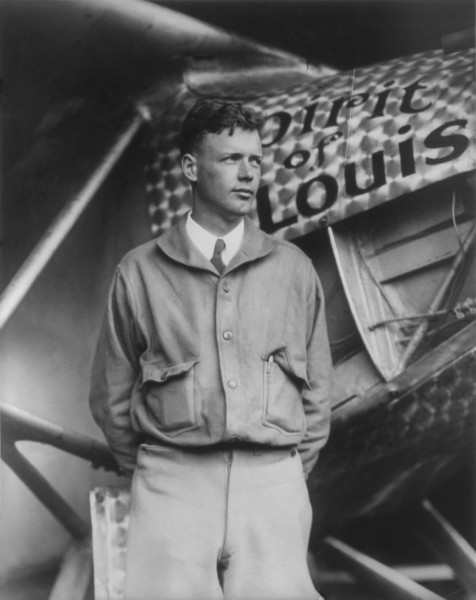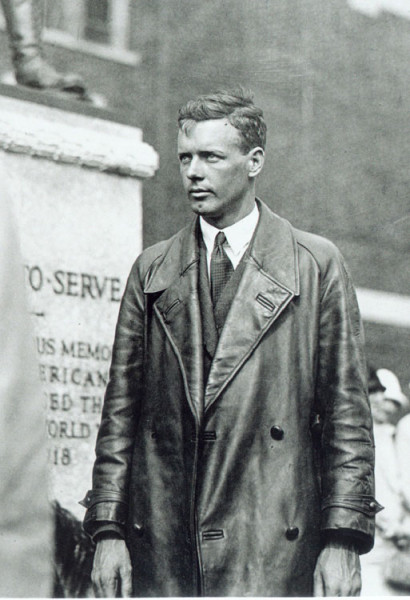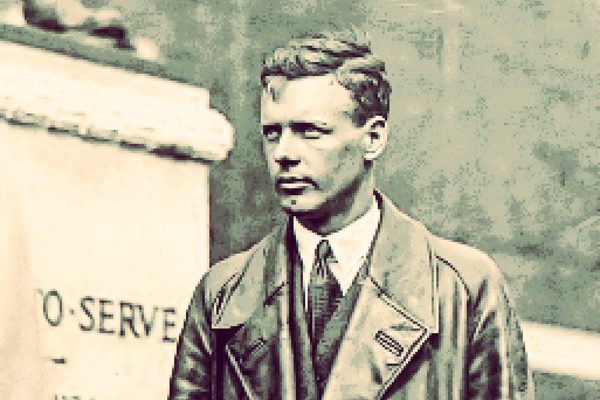By Gerry Griffith
The young people who loitered around Tom and Lizzie Minns’ little confectionary in South Wheeling on an early summer afternoon in 1927 were excited about the newspaper story that one young man summarized for the little gathering. It was big news for Wheeling. Charles Lindbergh was coming!
Tom, the short, blind, Irish mentor to young people and proprietor of little neighborhood stores, stood behind his counter where he presided over the vast collection of penny candy, pop, simple grocery items, and Wheeling newspapers that he sold to his neighbors. Lizzie, his wife who was also blind, stood in the doorway that led from the storefront to the couple’s modest living quarters. Eight-year-old daughter Mabel stood beside Lizzie and took in the scene. The reader had the rapt attention of everybody in the room.
“It says here that Lindy will land, probably at Langin Field in Moundsville on Aug. 4 and spend about a day in Wheeling with a parade and everything,” the young man explained to his listeners. “It looks like he will even be laying a wreath at that statue in front of Linsly Institute. You know, that statue of that pilot from the war who was from Wheeling.”

Tom, who was enthusiastic over just about everything, had a huge smile on his face and reached out for young Mabel’s embrace. He was especially excited about this news. He recognized the importance of a visit to Wheeling by America’s greatest aviation hero. He had already begun to hatch a plan to capture a memory that his little daughter would never forget. He would make sure she had a prime spot to see young Lindbergh during his Wheeling appearance. It would be a day he wanted to savor as well. After all, she would be his eyes too.
The spunky little entrepreneur had friends all over Wheeling. For more than a decade, he had operated a confectionary in various locations throughout the neighborhood that had served as local hangouts for a generation of young people. Those early “loafers,” as his family called the from 1917 on, were adults now. They were cops, newspaper reporters, gamblers with “connections,” downtown shop owners, and department store managers. Tom’s little store had been the place where lifelong friendships were made. Each of the loafers had taken a different path in life, but all remained loyal to the little blind Irishman. It was quite a network, and Tom planned to use it for the big Lindbergh visit.
Mabel wasn’t quite sure what all the excitement was about, but she learned from the time she could walk that when her daddy got that certain smile on his face, something good was about to happen.
Lindbergh, fresh from his May 20-21, 1927, record-setting solo flight across the Atlantic, made Moundsville and Wheeling significant stops on his three-month flying tour of all 48 states to promote aviation. Dwight Morrow, a West Virginia native who was friends with President Coolidge and would eventually become Lindbergh’s father-in-law, persuaded millionaire businessman/aviator Harry Guggenheim to finance Lindbergh’s tour. Wheeling was the state’s most populated city in 1927 and was designated as the site for the Mountain State’s lone Lindbergh visit. His tour started and ended at Long Island’s Mitchell Field, and when it was all said and done, Lindbergh delivered 147 speeches and rode 1,290 miles in parades. Wheeling contributed five miles to that parade total.
On a sunny morning two weeks before Lindbergh’s Wheeling visit, Tom grabbed his fedora and the little Charlie Chaplin style bamboo cane he used to navigate Wheeling’s brick and concrete sidewalks. He headed north on Jacob Street for a brisk two-mile walk to the offices of the Wheeling Intelligencer, where he knew a reporter or two. Then, he made his way over to one of the fancy restaurants on Market Street where it was rumored you could get in an illegal card game. When he returned home, thanks to a few helpful conversations, he knew precisely where and when the big parade would begin and end and the right place to stand for the big moment when Lindy and his entourage would pass by on their way to Wheeling Island Stadium, where he was to give a speech about aviation. With a little help from his friends, it would be a day to remember.
Finally, the big day arrived. Mabel was dressed in her best outfit, and her daddy was decked out in his finest suit. He took her elbow, and she led him north to a spot at the corner of Water and 12th streets near Wheeling’s traditional wharf area that offered an unobstructed view of the Ohio River and the airspace above it. A police sergeant who used to hang out at Tom’s store led Mabel and Tom through the crowd to a place another officer had staked out for them to stand in for a view of the anticipated Lindbergh flyover. When they arrived, the sergeant guided Mabel and Tom to a place along the curb where they waited along with the thousands of other excited observers who lined Wheeling streets from Benwood to the Suspension Bridge.
The crowd was buzzing with excited chatter until a motor was heard in the northern sky. It was a steady drone. People looked up. Those without hats shaded their eyes to get a better view. Mabel described the scene to her Daddy who held her hand tightly. Finally, at about noon, a biplane appeared. It wasn’t Lindy. It was a pilot they learned later was an Army advance man named Jimmy Doolittle, who would become a hero in his own right for a series of aviation accomplishments culminating with his famous WWII bombing raid on Tokyo. Doolittle did a few rolls and wing wiggles for the crowd as he headed south for Moundsville’s Langin Field. The flyover seemed to excite the crowd even more and within a few minutes, another engine was heard as it approached from the north over the Ohio River. It was him! It was the Spirit of St. Louis! The crowd burst into applause and cheering and Tom could barely hear Mabel describe what she was seeing over the tremendous roar. Lindy wiggled his wings and waved his hand out the cockpit side window. It caused the crowd to erupt in waves of noise along the riverside street and along the banks of Wheeling Island as the famous little plane passed—a commotion that Mabel and Tom could hear for the next several minutes as Lindy headed further south.
Now it was time to get ready for a close-up view. Two other friends of Tom’s in expensive suits and broad-brimmed fancy hats gently guided Mabel and her father up 12th Street to a spot at the corner of 12th and Market streets. There they winked at two other men who quickly and smoothly gave their spots right along the curb to Mabel and Tom. They were now perfectly positioned for Lindy’s arrival in the open touring car that he would ride in from Moundsville to Wheeling Island. They had more than an hour to wait. It was nearly 2:30 in the afternoon before Mabel and Tom began to hear cheering coming from the south that wafted over the streets and got louder and louder. Newspaper accounts report that more than 100,000 people lined the streets to greet Lindy that day in Wheeling.
The motorcade moved very slowly as the young man with tousled hair waved and smiled to the mass of humanity that lined the streets for miles. Finally, there he was, right in front of Mabel, who smiled and waved her handkerchief as her daddy stood behind her beaming with pride and excitement. He seemed to look right at her as he passed by, and Mabel squeezed her father’s hand tightly. Tom bent down to hear Mabel describe the scene and patted her arm in excited commiseration. In about 60 seconds, it was over. Lindy and his police escort were off for Wheeling Island, where he delivered a three-minute speech about the importance of new airports to advance commercial aviation.

By the time Lindbergh arrived at Linsly Institute to lay a wreath at the foot of the Louis Bennet memorial statue that was called “The Aviator,” Tom and Mabel had made their way home. (Bennet was West Virginia’s only air ace of WWI. His tribute statue then stood in front of the old Linsly building where Kroger now stands. Lindbergh probably laid his wreath at the very same spot on earth where people now stand in line to have their groceries scanned.)
Back home, Lizzie and a store full of young people waited to hear 8-year-old Mabel deliver a report on all she and Tom had experienced that day. Lindbergh went on to Wheeling’s Scottish Rite Cathedral for a banquet attended by 850 guests and, finally, a night’s rest at the Fort Henry Club on Chapline Street before departing for Dayton, Ohio, the following morning.
It was a day for Mabel to remember and to share with offspring 40 years later.
Read Part 1 of The Mabel Files here.


